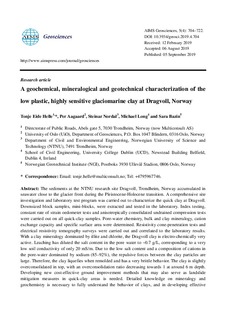| dc.description.abstract | The sediments at the NTNU research site Dragvoll, Trondheim, Norway accumulated in seawater close to the glacier front during the Pleistocene-Holocene transition. A comprehensive site investigation and laboratory test program was carried out to characterize the quick clay at Dragvoll. Downsized block samples, mini-blocks, were extracted and tested in the laboratory. Index testing, constant rate of strain oedometer tests and anisotropically consolidated undrained compression tests were carried out on all quick-clay samples. Pore-water chemistry, bulk and clay mineralogy, cation exchange capacity and specific surface area were determined. Resistivity cone-penetration tests and electrical resistivity tomography surveys were carried out and correlated to the laboratory results. With a clay mineralogy dominated by illite and chlorite, the Dragvoll clay is electro-chemically very active. Leaching has diluted the salt content in the pore water to~0.7 g/L, corresponding to a very low soil conductivity of only 20 mS/m. Due to the low salt content and a composition of cations in the pore-water dominated by sodium (85-92%), the repulsive forces between the clay particles are large. Therefore, the clay liquefies when remolded and has a very brittle behavior. The clay is slightly overconsolidated in top, with an overconsolidation ratio decreasing towards 1 at around 6 m depth. Developing new cost-effective ground improvement methods that may also serve as landslide mitigation measures in quick-clay areas is needed. Detailed knowledge on mineralogy and geochemistry is necessary to fully understand the behavior of clays, and in developing effective ground improvement methods by chemical additives. This paper present geochemical, mineralogical and geotechnical data from the quick clay at Dragvoll. A field experiment at Dragvoll showed that potassium chloride can be used as landslide mitigation in quick-clay areas, inhibiting retrogressive landslides and reducing the risk for progressive landslides. | |
